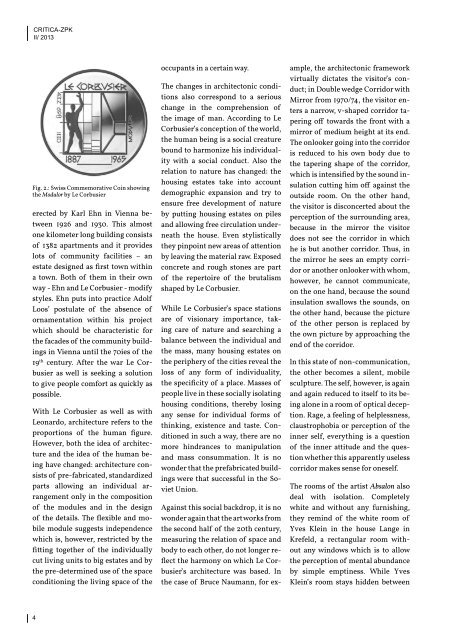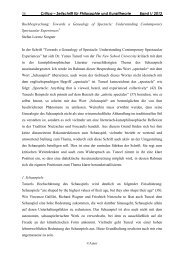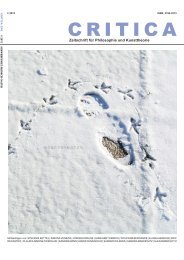Band II/ 2013 (7mb) - critica – zeitschrift für philosophie & kunsttheorie
Band II/ 2013 (7mb) - critica – zeitschrift für philosophie & kunsttheorie
Band II/ 2013 (7mb) - critica – zeitschrift für philosophie & kunsttheorie
Sie wollen auch ein ePaper? Erhöhen Sie die Reichweite Ihrer Titel.
YUMPU macht aus Druck-PDFs automatisch weboptimierte ePaper, die Google liebt.
CRITICA-ZPK<br />
<strong>II</strong>/ <strong>2013</strong><br />
Fig. 2.: Swiss Commemorative Coin showing<br />
the Modulor by Le Corbusier<br />
erected by Karl Ehn in Vienna between<br />
1926 and 1930. This almost<br />
one kilometer long building consists<br />
of 1382 apartments and it provides<br />
lots of community facilities – an<br />
estate designed as first town within<br />
a town. Both of them in their own<br />
way - Ehn and Le Corbusier - modify<br />
styles. Ehn puts into practice Adolf<br />
Loos’ postulate of the absence of<br />
ornamentation within his project<br />
which should be characteristic for<br />
the facades of the community buildings<br />
in Vienna until the 70ies of the<br />
19 th century. After the war Le Corbusier<br />
as well is seeking a solution<br />
to give people comfort as quickly as<br />
possible.<br />
With Le Corbusier as well as with<br />
Leonardo, architecture refers to the<br />
proportions of the human figure.<br />
However, both the idea of architecture<br />
and the idea of the human being<br />
have changed: architecture consists<br />
of pre-fabricated, standardized<br />
parts allowing an individual arrangement<br />
only in the composition<br />
of the modules and in the design<br />
of the details. The flexible and mobile<br />
module suggests independence<br />
which is, however, restricted by the<br />
fitting together of the individually<br />
cut living units to big estates and by<br />
the pre-determined use of the space<br />
conditioning the living space of the<br />
occupants in a certain way.<br />
The changes in architectonic conditions<br />
also correspond to a serious<br />
change in the comprehension of<br />
the image of man. According to Le<br />
Corbusier’s conception of the world,<br />
the human being is a social creature<br />
bound to harmonize his individuality<br />
with a social conduct. Also the<br />
relation to nature has changed: the<br />
housing estates take into account<br />
demographic expansion and try to<br />
ensure free development of nature<br />
by putting housing estates on piles<br />
and allowing free circulation underneath<br />
the house. Even stylistically<br />
they pinpoint new areas of attention<br />
by leaving the material raw. Exposed<br />
concrete and rough stones are part<br />
of the repertoire of the brutalism<br />
shaped by Le Corbusier.<br />
While Le Corbusier’s space stations<br />
are of visionary importance, taking<br />
care of nature and searching a<br />
balance between the individual and<br />
the mass, many housing estates on<br />
the periphery of the cities reveal the<br />
loss of any form of individuality,<br />
the specificity of a place. Masses of<br />
people live in these socially isolating<br />
housing conditions, thereby losing<br />
any sense for individual forms of<br />
thinking, existence and taste. Conditioned<br />
in such a way, there are no<br />
more hindrances to manipulation<br />
and mass consummation. It is no<br />
wonder that the prefabricated buildings<br />
were that successful in the Soviet<br />
Union.<br />
Against this social backdrop, it is no<br />
wonder again that the art works from<br />
the second half of the 20th century,<br />
measuring the relation of space and<br />
body to each other, do not longer reflect<br />
the harmony on which Le Corbusier’s<br />
architecture was based. In<br />
the case of Bruce Naumann, for example,<br />
the architectonic framework<br />
virtually dictates the visitor’s conduct;<br />
in Double wedge Corridor with<br />
Mirror from 1970/74, the visitor enters<br />
a narrow, v-shaped corridor tapering<br />
off towards the front with a<br />
mirror of medium height at its end.<br />
The onlooker going into the corridor<br />
is reduced to his own body due to<br />
the tapering shape of the corridor,<br />
which is intensified by the sound insulation<br />
cutting him off against the<br />
outside room. On the other hand,<br />
the visitor is disconcerted about the<br />
perception of the surrounding area,<br />
because in the mirror the visitor<br />
does not see the corridor in which<br />
he is but another corridor. Thus, in<br />
the mirror he sees an empty corridor<br />
or another onlooker with whom,<br />
however, he cannot communicate,<br />
on the one hand, because the sound<br />
insulation swallows the sounds, on<br />
the other hand, because the picture<br />
of the other person is replaced by<br />
the own picture by approaching the<br />
end of the corridor.<br />
ln this state of non-communication,<br />
the other becomes a silent, mobile<br />
sculpture. The self, however, is again<br />
and again reduced to itself to its being<br />
alone in a room of optical deception.<br />
Rage, a feeling of helplessness,<br />
claustrophobia or perception of the<br />
inner self, everything is a question<br />
of the inner attitude and the question<br />
whether this apparently useless<br />
corridor makes sense for oneself.<br />
The rooms of the artist Absalon also<br />
deal with isolation. Completely<br />
white and without any furnishing,<br />
they remind of the white room of<br />
Yves Klein in the house Lange in<br />
Krefeld, a rectangular room without<br />
any windows which is to allow<br />
the perception of mental abundance<br />
by simple emptiness. While Yves<br />
Klein’s room stays hidden between<br />
4




